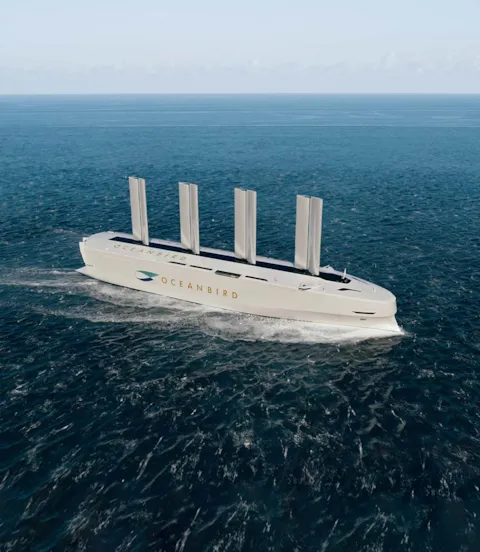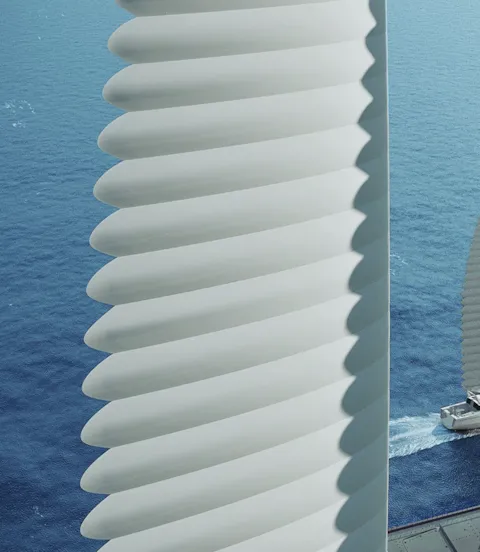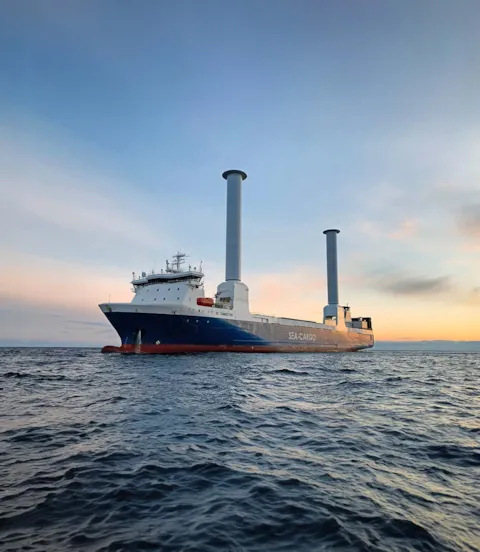Wind propulsion for RoRo, RoPax and pax vessels
The shipping world is looking for the right answers to the decarbonization challenge, and wind-assisted propulsion is seeing growing support from innovators and first movers across the industry. DNV presents three promising technologies adapted in the RoRo and RoPax segment.
As carbon emission limits get tighter and the zero-carbon goal moves closer, shipowners and ship operators are seeing more questions than answers about the ship-propulsion technology of a decarbonized tomorrow. Amid this uncertainty, one thing remains certain: There will always be wind – enough for everyone. “Wind has propelled ships for thousands of years, interrupted only for one brief, wasteful century of burning fossil fuels,” says Hasso Hoffmeister, Senior Principal Engineer at DNV. “So more people are asking: Why not use wind again?”

Advanced wind technology to the fore!
Today’s transport volumes are infinitely larger than those at the height of the windjammer era. Yesterday’s wind technology won’t do – wind propulsion must be reinvented using every bit of advanced engineering, material science, computer modelling and automation technology that is available. “DNV has a long history of wind expertise to draw from and supports modern visionaries who are ready to take the first step,” Hoffmeister emphasizes. “Ro-ro, ro-pax and pax ships are well suited for wind propulsion because they are comparatively lightweight, don’t travel at very high speeds, and typically have the open deck area required for sails, often with the superstructure in front so there are no line-of-sight issues,” he explains. It’s all a matter of making the leap of faith and trying things out that may look a bit unusual at first. Tomorrow’s wind propulsion won’t be “romantic” – but it can be impressive and harbour plenty of potential to reduce fuel costs and emissions, as these three examples show:

Oceanbird: the vertical airplane wing
The Oceanbird concept idea was developed in a research project between Wallenius Marine, the KTH Royal Institute of Technology and SSPA/RISE, with support from the Swedish Transport Administration. A crucial part of the concept is of course the rigid wing sails. To develop the wing sails into a marketable product, Wallenius and Alfa Laval formed the new company AlfaWall Oceanbird in December 2021.
The technical team at AlfaWall Oceanbird improved the design from the telescoping wing sail to a two-part articulated design reminiscent of a vertical airplane wing with a flap. “The flap creates an adjustable camber that can generate much more thrust than our previous wing sail concept,” explains Niclas Dahl, Managing Director of Oceanbird. “This new design allows us to achieve the same propulsion force with a much smaller sail – which is more sustainable by reducing material use.” The Oceanbird sail is hinged and can be tilted down to clear overhead obstacles and keep the ship stable in a storm.

Visionary technology to reduce fuel dependency
The next major step towards bringing the Oceanbird sail to full maturity will be a full-sized prototype installed on land to study its behaviour and operation, test the automated control system and train future operators. This will be followed by a prototype installation onboard Wallenius Wilhelmsen’s vessel Tiranna. “These are important steps that will allow us to learn,” says Dahl. “Our ultimate vision is to change the shipping industry. We see a very strong possibility for a technology that we know works and can be used effectively by employing advanced technologies. Wind assist avoids inescapable dependency on alternative fuels. Wind is a completely free and fully sustainable ‘fuel’.”

EU funding supports the ship development project
In January 2023, the EU Horizon Europe funding programme for research and innovation approved 9 million euros of funding for the Orcelle Wind project, which aims to develop and build a 220-metre wind-powered ro-ro vessel to be commissioned in late 2026 or early 2027. Eleven industry and academic partners, including Oceanbird and DNV, are collaborating in the project, addressing all aspects from the sails and their fully automated control system to hull design, safety and crew training. The Pure Car and Truck Carrier will transport over 7,000 vehicles across the oceans.

Wind: sustainable, inexhaustible and predictable
AlfaWall Oceanbird’s Technical Director Mikael Razola points out: “Everybody will be competing for the alternative fuels, but nobody competes for wind. Wind is inexhaustible and actually quite predictable.” Furthermore, the investment, operating and maintenance costs of wing sails will soon be known whereas predicting the future costs associated with other fuels is difficult, says Dahl. It shouldn’t be forgotten, he adds, that there is a certain “wow!” factor: “Sails are good for the environment, good for CII compliance, and very visible to the public who can see you are doing something for the environment.”

Demonstrating a compelling business case for wind propulsion
“Wind is a no-brainer,” concludes Razola. “I imagine a future of autonomous sailing vessels travelling the oceans virtually without energy costs – a vision that is not completely utopian from today’s perspective.” All this hinges on the ability to demonstrate a compelling business case, says Dahl. “You harvest what is there already, without any specific environmental risks – and you don’t even need a fuel supply infrastructure!”

WISAMO: Michelin’s inflatable wing sail
The idea of an inflatable wing sail was first conceived by a group of sailing enthusiasts in Switzerland and soon adopted by French tyre manufacturer Michelin as a great way to expand its broad research and innovation programme. WISAMO – Wing Sail Mobility – is the name of the company’s initiative to develop this concept to full maturity. An initial prototype installed on a small sailboat 20 months ago has been tested successfully by the seasoned French sailing pro Michel Desjoyeaux, reports Gildas Quemeneur who heads the WISAMO initiative. “Some of the great advantages of this sail include its low weight and upwind efficiency – you can sail much closer to the wind than with a conventional sail. The design is simple, with a small number of components and very few connecting points. The textile material forms a stack of internal air chambers, held up by a telescoping, fully retractable mast and inflated by a fan.”

Collecting data on a demonstrator
A number of additional trials must be performed before the system is ready for use on cargo ships, says Quemeneur: A demonstrator wing sail is currently being tested on the RoRo ship MN Pélican, owned by WISAMO cooperation partner Compagnie Maritime Nantaise. “This is a scale model with a surface area of 100 square metres, so the scale is 1 to 5,” says Quemeneur. “We are fitting many measuring devices to gather performance data and sharpen our simulation and prediction tools. We will also use it to test the mechanical components and operation.”

Low-pressure system minimizes stresses and energy needs
The sail uses low air pressure, which keeps the mechanical stresses on the fabric low. The shape of the sail is maintained by lightweight horizontal stays between the air compartments. Especially in the upper portion of the sail it is crucial to control the rigidity, says Quemeneur. “While a significant air volume is needed to inflate the sail, maintaining the internal pressure takes very little energy,” he explains. “System safety is ensured by the fully automated control system which measures the wind and retracts the sail when the load limit is reached at wind speeds of around 55 knots. The textile material is expected to last 6 to 8 years and should be easy to replace.” He adds that the collapsed sail neatly fits into a stowage compartment that can be rotated out of the way of cranes and hatch covers.

Technical maturity builds confidence in ROI
During the second half of 2024, WISAMO will install a full-scale sail on land for further tests. “After evaluating the results, we will look for an early adopter to install a full set of our sails on a ship and determine how the sails interact with each other and the vessel,” says Quemeneur. “For the future commercial success of our system, it will be essential to reach full technical maturity and achieve a high level of confidence in the ROI.” DNV, who has been accompanying the project, has granted Approval in Principle for the system, an important step for WISAMO. Gildas expects a set of sails to generate 15 to 20 per cent of propulsion power when retrofitted, and 50 per cent or more on a custom “wind-powered cargo”-type newbuild.

Norsepower: the triumph of rotor sails
Gisle Kårbø Rong, Managing Director at Stödig Ship Management in Norway, proudly tells the story of SC Connector, the DNV-classed Sea-Cargo ro-ro ship that received two Norsepower rotor sails, certified according to DNV’s WAPS ST-0511 standard, in late 2020. Measuring 35 metres tall and 5 metres in diameter, they have completely changed the behaviour of the ship which operates in the North Sea area: “Before the retrofit, SC Connector was the vessel within our fleet that spent the most time in port because of bad weather which always caused extreme ship movements. Now she is the ship that spends the most time at sea! Her behaviour at sea has completely changed.”

Physical effects dampen ship movements
RoRo ships tend to be “stiff” due to their high metacentre (GM), explains Rong, so they roll and heave a lot, causing speed loss and discomfort for the crew. While Stödig, together with Norsepower and the Technical University in Trondheim, are still investigating the exact effects of the two rotor sails using many measuring devices on board, it is clear already that the gyroscopic effect, the sail surface and the elevated GM jointly stabilize the vessel to a very high degree. “The crew can see that their life is better when the sails are spinning, so the sailing propulsion has been received very well among the seafarers on board. The technical superintendent just came back from being on board with stars in his eyes, he was just amazed,” says Rong. An firsthand interview with the captain of SC Connector about his experience with rotor sails is available below the article.

A system that works and makes business sense
Between 20 and 25 per cent of the propulsion energy comes from the sails, says Rong. To allow SC Connector to pass under bridges, cranes and hanging cables, the rotor sails can be tilted down. “But the tilting mechanism is only used in these situations; you do not have to lower the sails in a storm because their dampening and stabilizing effects are very welcome.”
The rotor sails also make business sense for Stödig and Sea-Cargo, Rong emphasizes: “They maximize the availability and efficiency of the ship and reduce fuel consumption and emissions while fulfilling the ESG principles and expressing our own core value of innovation.” The bottom line, he summarizes, is that the system “simply works”.

Bringing partners together for innovation
As a partner in all these projects, DNV not only handles classification and approvals but also provides comprehensive technical advisory services and acts as a mediator between owners, suppliers and other parties to help build the kinds of networks that will bring together know-how from many players, including from outside the shipping industry. “This is how we can take wind propulsion and wind-assisted propulsion into the mainstream,” says DNV’s Hasso Hoffmeister.

- Oceanbird
- Michelin
- Sea Cargo